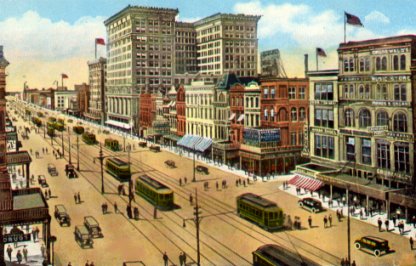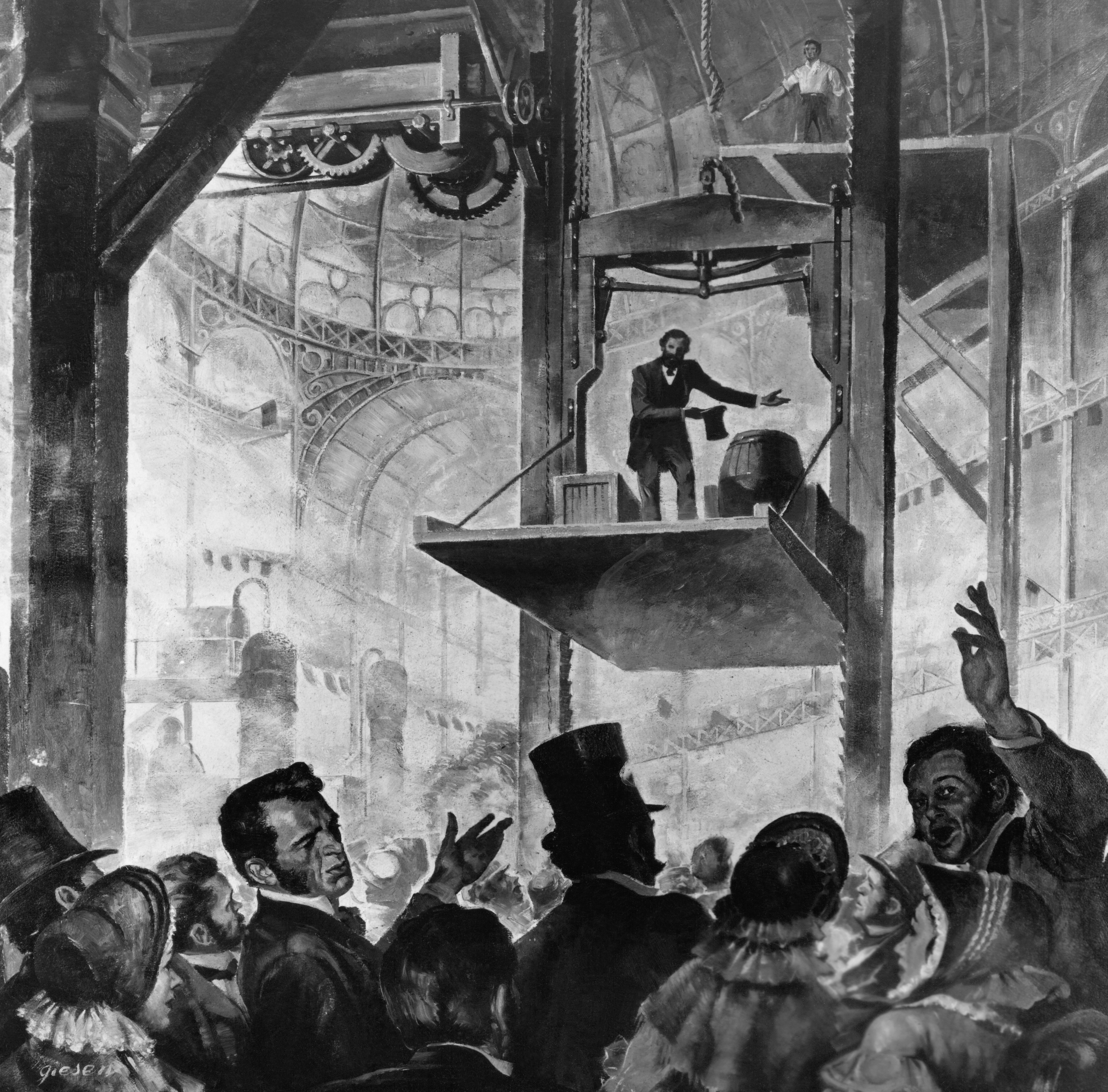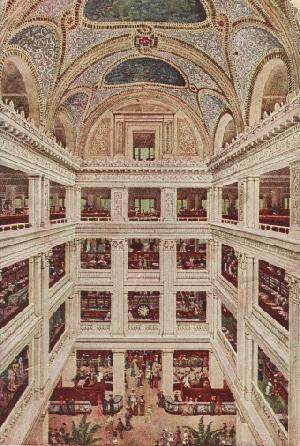|
Canal Street, New Orleans
Canal Street () is a major thoroughfare in the city of New Orleans. Forming the upriver boundary of the city's oldest neighborhood, the French Quarter or ''Vieux Carré'', it served historically as the dividing line between the colonial-era (18th-century) city and the newer American Sector, today's Central Business District, New Orleans, Central Business District. Up until the early 1800s, it was primarily Louisiana Creole people, Creoles who lived in French Quarter, the Vieux Carré. After the Louisiana Purchase (1803), a large influx of other cultures began to find their way into the city via the Mississippi River. A number of Americans from Kentucky and the Midwest moved into the city and settled uptown. Along the division between these two cultures, a canal was planned. The canal was never built but the street which took its place received the name. Furthermore, the median of the street became known as the Central reservation, neutral ground, acknowledging the cultural divi ... [...More Info...] [...Related Items...] OR: [Wikipedia] [Google] [Baidu] |
Streetcar
A tram (also known as a streetcar or trolley in Canada and the United States) is an urban rail transit in which vehicles, whether individual railcars or multiple-unit trains, run on tramway tracks on urban public streets; some include segments on segregated right-of-way. The tramlines or tram networks operated as public transport are called tramways or simply trams/streetcars. Because of their close similarities, trams are commonly included in the wider term '' light rail'', which also includes systems separated from other traffic. Tram vehicles are usually lighter and shorter than main line and rapid transit trains. Most trams use electrical power, usually fed by a pantograph sliding on an overhead line; older systems may use a trolley pole or a bow collector. In some cases, a contact shoe on a third rail is used. If necessary, they may have dual power systems—electricity in city streets and diesel in more rural environments. Occasionally, trams also carry frei ... [...More Info...] [...Related Items...] OR: [Wikipedia] [Google] [Baidu] |
Elevator
An elevator (American English) or lift (Commonwealth English) is a machine that vertically transports people or freight between levels. They are typically powered by electric motors that drive traction cables and counterweight systems such as a hoist, although some pump hydraulic fluid to raise a cylindrical piston like a jack. Elevators are used in agriculture and manufacturing to lift materials. There are various types, like chain and bucket elevators, grain augers, and hay elevators. Modern buildings often have elevators to ensure accessibility, especially where ramps aren't feasible. High-speed elevators are common in skyscrapers. Some elevators can even move horizontally. History Pre-industrial era The earliest known reference to an elevator is in the works of the Roman architect Vitruvius, who reported that Archimedes ( – ) built his first elevator probably in 236 BC. Sources from later periods mention elevators as cabs on a hemp rope, powered by people o ... [...More Info...] [...Related Items...] OR: [Wikipedia] [Google] [Baidu] |
Notions (sewing)
In sewing and haberdashery, notions are small objects or accessories, including items that are sewn or otherwise attached to a finished article, such as buttons, snap fastener, snaps, and collar stays. Notions also include the small tools used in sewing, such as Sewing needle, needles, yarn, thread, pins, marking pens, elastic (notion), elastic, and seam rippers. The noun is almost always used in the plural. The term is chiefly in American English (the equivalent British term is haberdashery). It was also formerly used in the phrase "Yankee notions", meaning American products. A fabric store will have a section or department devoted to notions, and a spool of thread is considered a notion. History Origins The roots of notions trace back around 25,000 years to the discovery of bone needles, a crucial tool in stitching garments made from fur. These early sewers also utilized thimbles to guard against occasional finger pricks, as evidenced by ancient artifacts. The emergence of butto ... [...More Info...] [...Related Items...] OR: [Wikipedia] [Google] [Baidu] |
Department Store
A department store is a retail establishment offering a wide range of consumer goods in different areas of the store under one roof, each area ("department") specializing in a product category. In modern major cities, the department store made a dramatic appearance in the middle of the 19th century, and permanently reshaped shopping habits, and the definition of service and luxury. Similar developments were under way in London (with Whiteleys), in Paris () and in New York City ( Stewart's). Today, departments often include the following: clothing, cosmetics, do it yourself, furniture, gardening, hardware, home appliances, houseware, paint, sporting goods, toiletries, and toys. Additionally, other lines of products such as food, books, jewellery, electronics, stationery, photographic equipment, baby products, and products for pets are sometimes included. Customers generally check out near the front of the store in discount department stores, while high-end traditional d ... [...More Info...] [...Related Items...] OR: [Wikipedia] [Google] [Baidu] |
Adler's Jewelry
Adler's Jewelry was founded in New Orleans in December 1898. It is located at 722 Canal Street in the city's historic shopping district. Early history Adler's began as Coleman Adler Jewelry in 1898 in a two-story shop on Royal Street in the French Quarter. In its early years, Adler's designed call-out favors and other jewelry for Mardi Gras krewes. In 1902, the store moved to 810 Canal Street. Canal Street, New Orleans was the shopping district of the region during the first half of the 20th century, and Coleman E. Adler was active in the Canal Street Commission for over thirty years. In 1904, Adler's was chosen to create the Times-Picayune Loving Cup awarded to educator Sophie B. Wright. Adler's designed and crafted the silver service of the State of Louisiana presented to the navy's ''U.S.S. Louisiana'' upon its first arrival at the port of New Orleans in December 1906. The firm moved to its current location at 722-724 Canal Street in 1909. In 1912, the State o ... [...More Info...] [...Related Items...] OR: [Wikipedia] [Google] [Baidu] |
Gus Mayer
Gus Mayer Stores Inc. is a Birmingham, Alabama, based, family-owned department store. The two-store chain is owned by the Pizitz Management Group. It has locations at The Summit in the Greater Birmingham area and The Mall at Green Hills in Nashville, both of which are known as high-end retail centers. Typical brands carried include 7 for all Mankind, Juicy Couture, Dolce & Gabbana, Roberto Cavalli, Gianfranco Ferré, Michael Kors, Zang Toi, Zac Posen, Lela Rose, St. John, Monique Lhuillier, and Burberry. It was founded in 1900; the original Gus Mayer department store was located on Canal Street in downtown New Orleans. At one time, there were more than 20 Gus Mayer stores across the Southeast and Southwest. The first Birmingham location opened in 1922 in the Retail Block behind the Molton Hotel on 5th Avenue North. Later the store was located at 2240 Highland Avenue in the Bottega Favorita location, now home to Bottega Restaurant & Cafe. Two years after the Brookwood Vill ... [...More Info...] [...Related Items...] OR: [Wikipedia] [Google] [Baidu] |
Maison Blanche
Maison Blanche (, ''White House'') was a department store in New Orleans, Louisiana, and later also a chain of department stores. It was founded in 1897 by Isidore Newman, an immigrant from Germany. Maison Blanche is perhaps best remembered for introducing the locally popular Mr. Bingle Christmas mascot and for its landmark flagship store on Canal Street. Corporate history Maison Blanche was acquired in 1923 by City Stores Company, which merged Maison Blanche with Loveman's in 1950. City Stores Co. filed for bankruptcy in July 1979. While in bankruptcy, they initially intended to consolidate the seven Maison Blanche stores with four B. Lowenstein's stores in Memphis, Tennessee, to form the Maison Blanche Department Stores group, but in early 1982 the Memphis stores were shuttered. Instead, three of the seven existing Maison Blanche stores, as well as the name, were purchased by Goudchaux's, Inc. of Baton Rouge, owned by the Sternberg brothers. Operating as Goudchau ... [...More Info...] [...Related Items...] OR: [Wikipedia] [Google] [Baidu] |
New Orleans Metropolitan Area
The New Orleans metropolitan area, designated the New Orleans–Metairie metropolitan statistical area by the Office of Management and Budget, U.S. Office of Management and Budget, or simply Greater New Orleans (, ), is a List of United States metropolitan areas, metropolitan statistical area designated by the United States Census Bureau encompassing seven Louisiana Parish (administrative division), parishes—the equivalent of County (United States), counties in other U.S. states—centered on the city of New Orleans. The population of Greater New Orleans was 1,007,275 in 2020. Greater New Orleans is the most populous metropolitan area in Louisiana, and the 45th most populous in the United States. The broader New Orleans–Metairie–Slidell combined statistical area had a population of 1,373,453 in 2020. The New Orleans metropolitan area was devastated by Hurricane Katrina—once a Saffir–Simpson Hurricane Scale#Category 5, category 5 hurricane, but a Category 3 hurricane, cat ... [...More Info...] [...Related Items...] OR: [Wikipedia] [Google] [Baidu] |
Boulevard
A boulevard is a type of broad avenue planted with rows of trees, or in parts of North America, any urban highway or wide road in a commercial district. In Europe, boulevards were originally circumferential roads following the line of former city walls. In North American usage, boulevards may be wide, multi-lane thoroughfares divided with only a central median. Etymology The word ''boulevard'' is borrowed from French. In France, it originally meant the flat surface of a rampart, and later a promenade taking the place of a demolished fortification. It is a borrowing from the Dutch word ' ' bulwark'. Notable examples Asia Azerbaijan *Baku Boulevard Bangladesh *Manik Mia Avenue Cambodia *Norodom Boulevard *Monivong Boulevard *Sihanouk Boulevard India * M G Road * Anna Salai * Indira Gandhi Sarani * Marine Drive * Krishnaraja Boulevard * Rajpath * Necklace Road * Mahatma Gandhi Road * Foreshore Road Indonesia * Jalan Jenderal Sudirman *Jalan M.H. Thamrin * Jalan Jen ... [...More Info...] [...Related Items...] OR: [Wikipedia] [Google] [Baidu] |
Street Name
A street name is an identifying name given to a street or road. In toponymic terminology, names of streets and roads are referred to as odonyms or hodonyms (from Ancient Greek 'road', and 'name', i.e., the Doric Greek, Doric and Aeolic Greek, Aeolic form of 'name'). The street name usually forms part of the address (geography), address (though addresses in some parts of the world, notably most of Japanese addressing system, Japan, make no reference to street names). Buildings are often given House numbering, numbers along the street to further help identify them. Odonymy is the study of road names. Names are often given in a two-part form: an individual name known as the ''specific'', and an indicator of the type of street, known as the ''generic''. Examples are "Main Road", "Fleet Street" and "Park Avenue". The type of street stated, however, can sometimes be misleading: a street named "Park Avenue" need not have the characteristics of an avenue (landscape), avenue in th ... [...More Info...] [...Related Items...] OR: [Wikipedia] [Google] [Baidu] |







